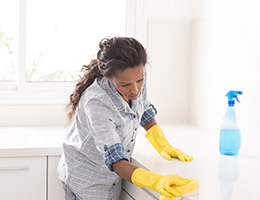
When it comes to keeping your family safe from viruses and bacteria that can make them ill, it's hard to beat frequent handwashing and routine vaccinations. But there's also a case to be made for cleaning and disinfecting surfaces around the home where germs may linger.
As part of your overall prevention strategy, this simple step may help reduce the spread of germs that cause the flu, colds, foodborne illnesses and more.
Where germs hide out
Some germs, such as those that cause the flu, are most often spread through coughs and sneezes. But surface contamination can play a role. For example, viruses can live on a doorknob or other surfaces for hours. It's not unusual to touch a contaminated surface and then touch your face, potentially infecting yourself with germs.
In addition, salmonella or other harmful bacteria that may be in foods can spread to kitchen surfaces and then to other foods or someone's hands.
Surfaces and objects that can become contaminated include:
- Doorknobs.
- Shared telephones.
- Computer keyboards.
- TV remotes.
- Faucets.
- Bathroom surfaces.
- Kitchen counters and cutting boards.
- Tabletops and desks.
Make it a habit
While frequent disinfecting is particularly important when someone in the house is ill, it's a good idea to disinfect as part of your routine cleaning regimen, regardless of the season.
For example, foodborne infections are a risk all year, making it essential to clean kitchen surfaces regularly—especially after working with raw meat or poultry.
Dirt-free isn't germ-free
At a minimum, surfaces should be regularly cleaned with soap and water to remove grime and germs. But for extra protection, you'll need to disinfect afterward, which kills germs. That's particularly true for kitchen and bathroom surfaces, according to the Centers for Disease Control and Prevention (CDC).
Most household disinfectants registered by the U.S. Environmental Protection Agency (EPA) should work fine. You can also make your own disinfectant bleach solution in large or small batches.
Follow the manufacturer's instructions for cleaning and disinfecting electronics, such as tablets, touch screens, keyboards and remote controls.
Clean safely
Following the label directions can help ensure that you use the product safely and that it does the most good. For example, you may need to let a disinfectant stand for a few minutes before wiping down the surface.
For safety's sake, consider these suggestions from CDC:
- When using bleach or other cleaning products, wear gloves and make sure you have good ventilation.
- Keep products in their original containers and out of the reach of children.
- Never mix cleaning products together.
Remember that cleaning and disinfecting shouldn't be your only strategies for preventing infection. Handwashing, routine vaccinations and safe food-handling practices, for example, should be habits as well.
Reviewed 6/17/23